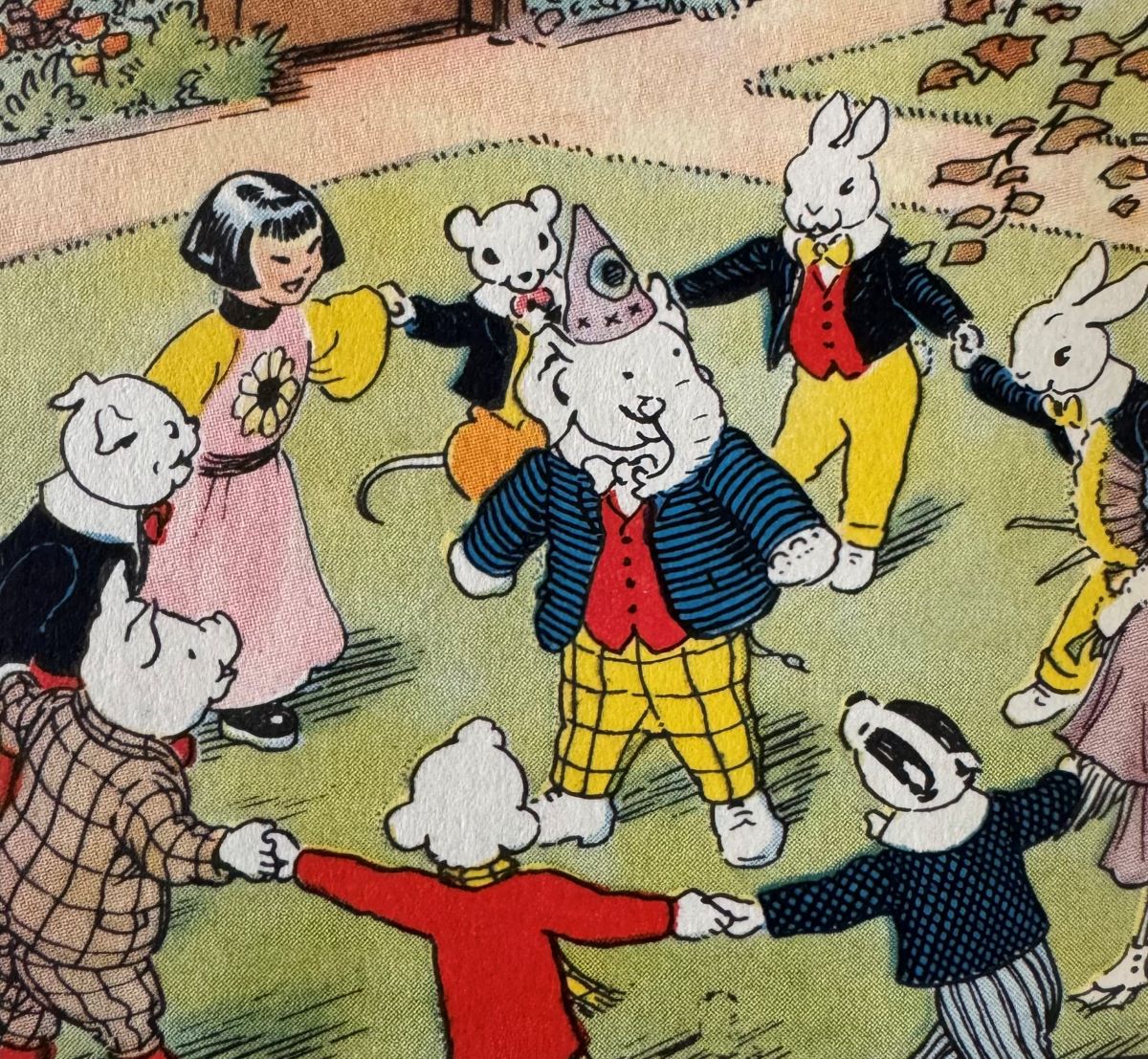The character of Rupert Bear was created by Mary Tourtel in 1920, first appearing in a comic strip in the Daily Express (collated in annuals from 1936, initially in red, white and black, and then in full colour from 1940). Alfred Bestall took over as the illustrator in 1935, followed by Alex Cubie, John Harrold, and Stuart Trotter, the current incumbent, and, whilst there are some discernible changes in style, both the characters and their world have remained recognisable.
Rupert lives in the village of Nutwood, surrounded by friends and family, and has regular adventures in the surrounding countryside (apparently inspired by the landscapes of Surrey, the Sussex Weald, Severn Valley, and North Wales), as well as locations further afield, including the seaside, desert islands, Santa Claus’ castle, and the North Pole. Various gardens feature in these excursions, mostly as background, but occasionally as key elements of the plot. This first post in an occasional series reflects the findings of some research into the number and nature of gardens in and around Nutwood, as presented in annuals from ‘the long 1940s’ (1938, and 1942-1950).
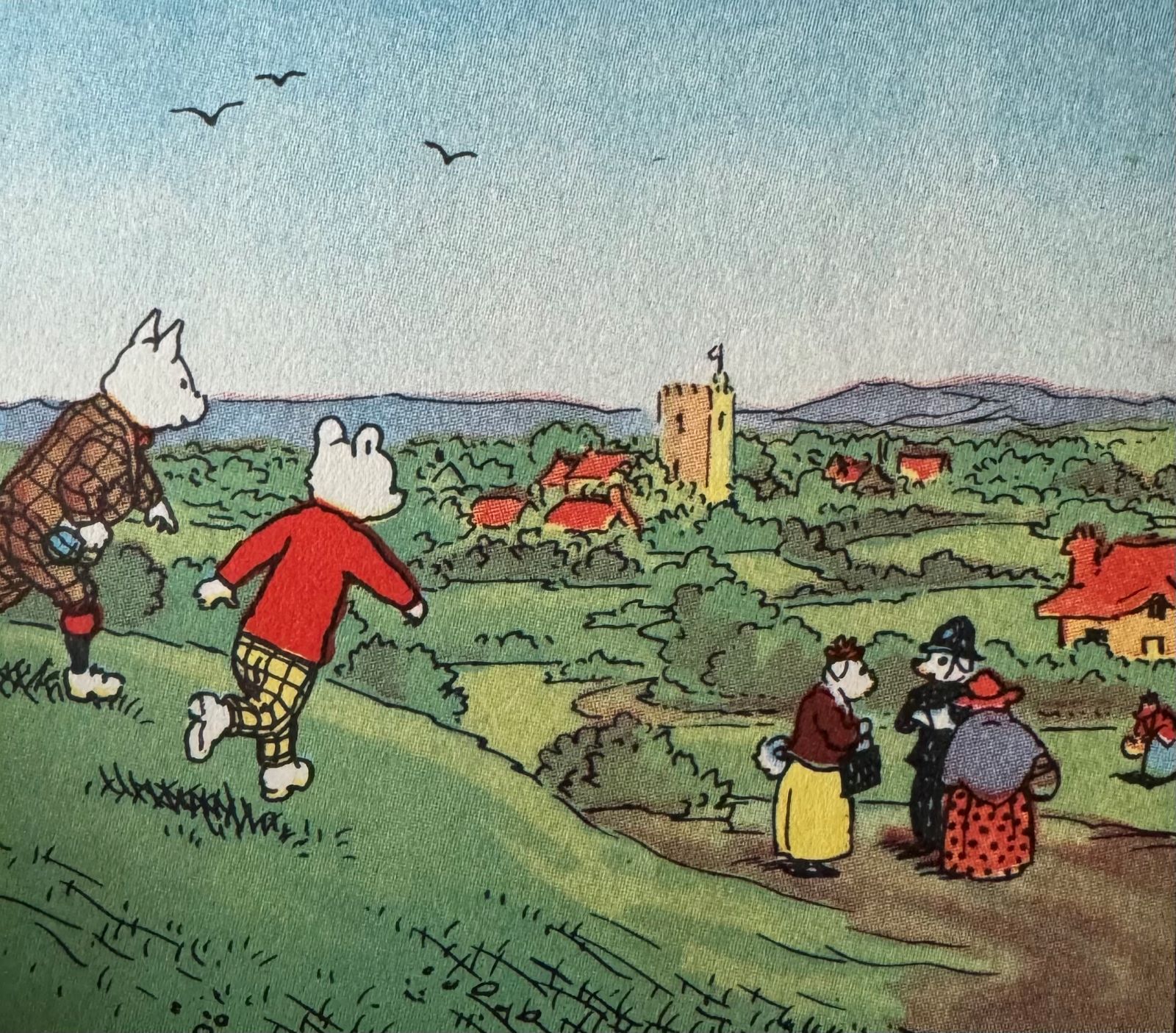
Rupert’s Cottage
Rupert Bear’s own home features strongly in the stories, not least because Alfred Bestall felt that the adventures ‘must always begin and end in or near his own cottage [to help] to make Rupert’s wonderland more real’ (Hilda Coe, writing in the Daily Express in 1945, as cited by Caroline Bott in The Life and Works of Alfred Bestall – Illustrator of Rupert Bear, 2011).
It may make regular appearances, but it does not always look the same: there are surprising variations in its form over the years, but also within the same annual, or even within the same story. For the most part, the house is a one-storey thatched cottage, though it occasionally has a dormer over the central front door, of varying shapes.
The house appears to be centred within the plot, in common with most of the houses and gardens in the Rupert stories. The Bears’ front garden is – usually – quite small, but appears to expand as the plot of a given story dictates. It also contracts, disappearing altogether with reasonable frequency, so that the front door opens straight on to the lane. Mostly, however, it features a gate in the centre of a hedge, aligned with a gravel path to the front door. The gate is always square, but is sometimes shown as a single panel of wood, and sometimes as tongue and groove. It is most often bare wood but occasionally painted blue, or various shades of green. The latch is almost always round, but moves from one side of the gate to the other, and changes colour with the same sort of frequency. The hedge within which it sits sometimes transforms into a fence.
Within the front garden, there is usually a flowerbed of varying depth adjoining the hedge/fence, and then a lawn, with borders to left and right that are filled with flowers and/or shrubs (and, often, a similar border under the windows of the house, sometimes with a climber), and the occasional tree.
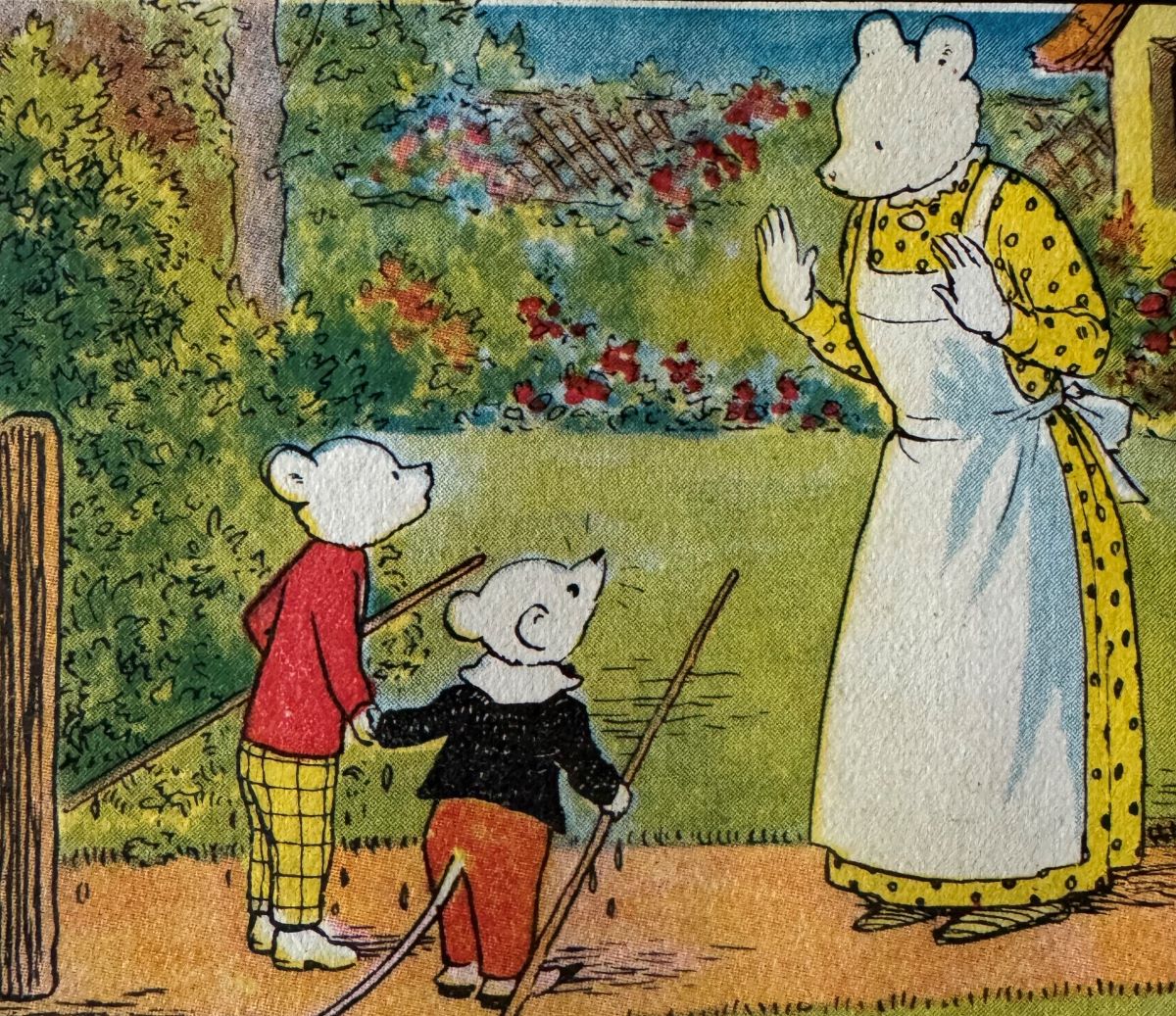
It’s less clear what’s happening to the side and rear of the house. For the most part, there appears to be no space at all to either side of the cottage, but sometimes there is room for a shed. A large garden filled with vegetable beds is part of the Bears’ estate, but whether this is to the rear, rapidly-altering sides or indeed the front (replacing the lawn) is not explained. Somewhere in all this is also a sizeable and well-established orchard, with at least six large apple trees – although sometimes there are also espaliered apples in the front garden.
In terms of facilities, there is space – perhaps in the orchard – for a washing line (where there is certainly a swing), and, elsewhere, to have a bonfire (though Mr Bear does not allow the burning of leaves). There is the aforementioned shed, and also an outside tap, wooden rainwater barrel, wood store, stash of terracotta pots, and, sometimes, a side gate. The fence to the side of the house is sometimes solid and tall, with or without trellis on top, and sometimes a picket fence.
All of which is supplemented by the Bears’ allotment, with very large but mostly empty beds, in which one can find the occasional cabbage. All gardening, whether at home or in the allotment, looks to be Mr Bear’s responsibility, undertaken with regular input from Rupert (though this is not always helpful: inadvertently lighting a bonfire with a firework was not well-received, nor accidentally spraying passers-by with insecticide).

The Cottages of Nutwood
The Bears’ home is very much in keeping with those of other households within Nutwood: most homes appear to be modest in size, and vernacular in style and construction, with small gardens to the front (and unspecified land to the rear). Reflecting the styles of the 1930s and 1940s, these gardens are generally quite formal in structure, with straight paths, square lawns, and narrow flowerbeds at the margins, though within this form the planting – which is slightly abstract in the artwork – generally reflects the cottage garden tradition.
Starting with the homes of Rupert’s circle of friends, Bill Badger’s house is one such, albeit breaking the formal mould by boldly placing its water butt to the side of the front door. A holiday cottage selected by Mrs Badger is similar again, albeit with a trellised porch covered in roses. The flowerbeds at Podgy Pig’s house are distinguished by scalloped edging, whilst the planting at Algy Pug’s is more effusive, and finished with rope top edging. Edward Trunk’s cottage varies significantly. On occasion, it does not have a front garden per se, just some greenery bordering a path, with lath-and-wire fencing to the side, but can also be seen with a side gate, shed, gravel path between areas of lawn, and flower- and shrub-filled borders, or a front gate opening to a cobbled path through a lawn.
Billy Goat’s front garden is perhaps most similar to Rupert’s, with a wooden gate (either plain or more decorative than the norm) flanked by a hedge, narrow borders, central path through a lawn, and the occasional tree or shrub in the corners of the plot. On the house, there is a climber, and, outside his grandmother’s room, a window box. Willie Mouse’s cottage also has a path through the front garden to the door, a hedge, and rainwater barrel, along with shrubs under the windows of the house.
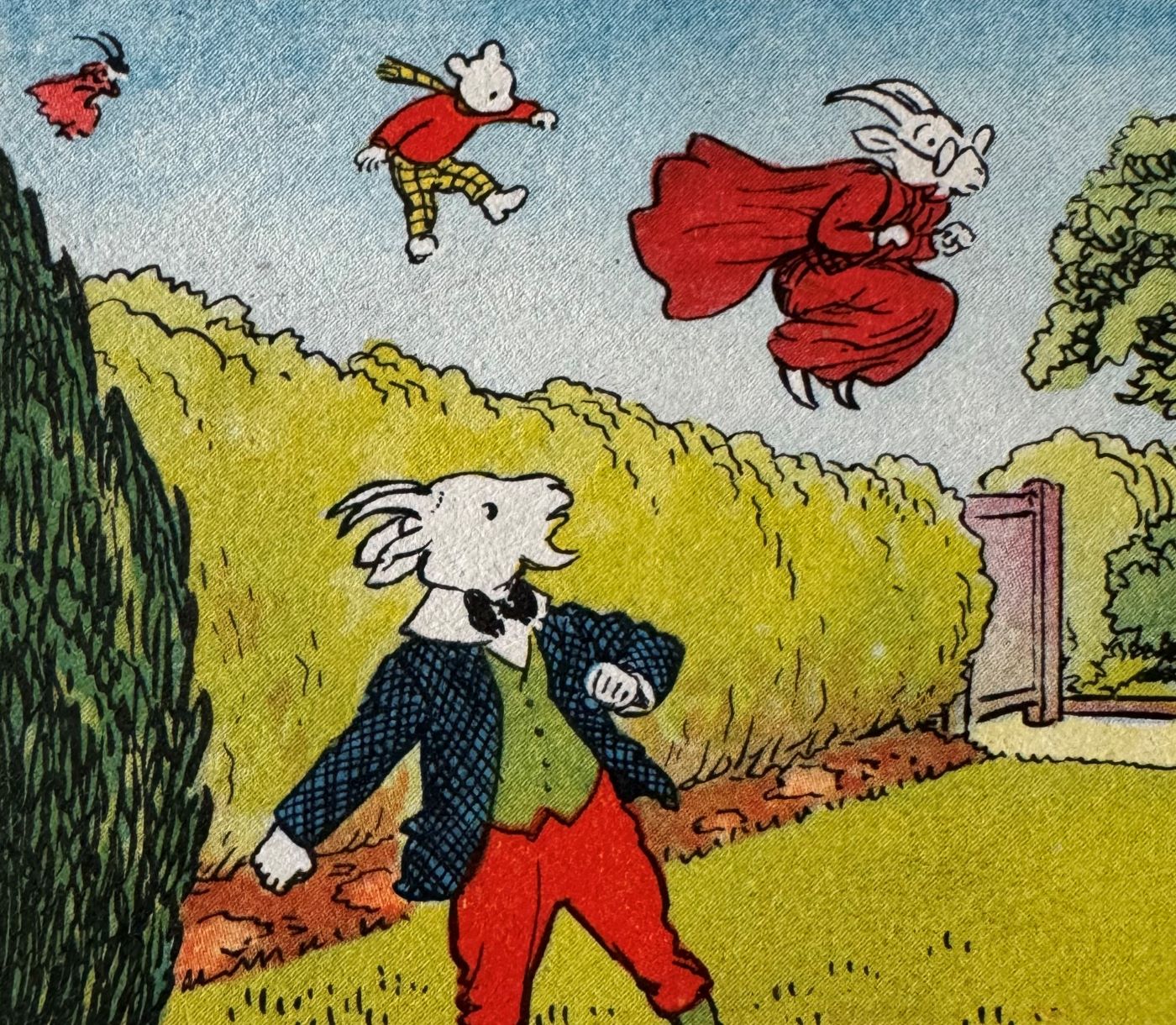
Occasional and once-only characters are also often seen with their gardens – the Nutwood community is tight-knit, and there is much visiting, either socially or in pursuit of a lost animal (a surprisingly common occurrence). The front garden at Mrs McPherson’s has the expected straight paths and lawn, and, like the Badgers’ holiday cottage, a trellised porch covered in roses (which also climb up the front of the house), with a small fruit tree nearby. The rear garden is very different in style, with a large, informal lawn, surrounded by large shrubs, and a washing line. The fenced front garden of the unnamed lady who lives at Myrtle Cottage is another in this style, with an edged path leading to the front door (which has roses growing around it), and deep beds filled with shrubs and flowers. The garden to the rear is less formal, with a large shed, woodpile, collection of terracotta pots awaiting use, and less pristine lawn. Peter’s cottage (where he and his grandfather are living temporarily) is thatched, in the centre of a lush cottage garden bounded by a hedge and gate.
Mrs Sheep’s cottage has a wooden gate, substantial hedge, and a flagpole. The front garden has an abundance of cottage garden plants, of sufficient height and density for a tiger to hide within (about which she was remarkably sanguine). An unnamed ‘village woman’ has a small cottage amongst Nutwood’s shops, which opens to a small grass verge between the house and street. A similarly unnamed ‘old man’ has a slightly more remote cottage, with a hedge, fence, blue gate, shrubs, a narrow strip of lawn, and sunflowers, as well as a slightly unkempt path, and a rainwater barrel.
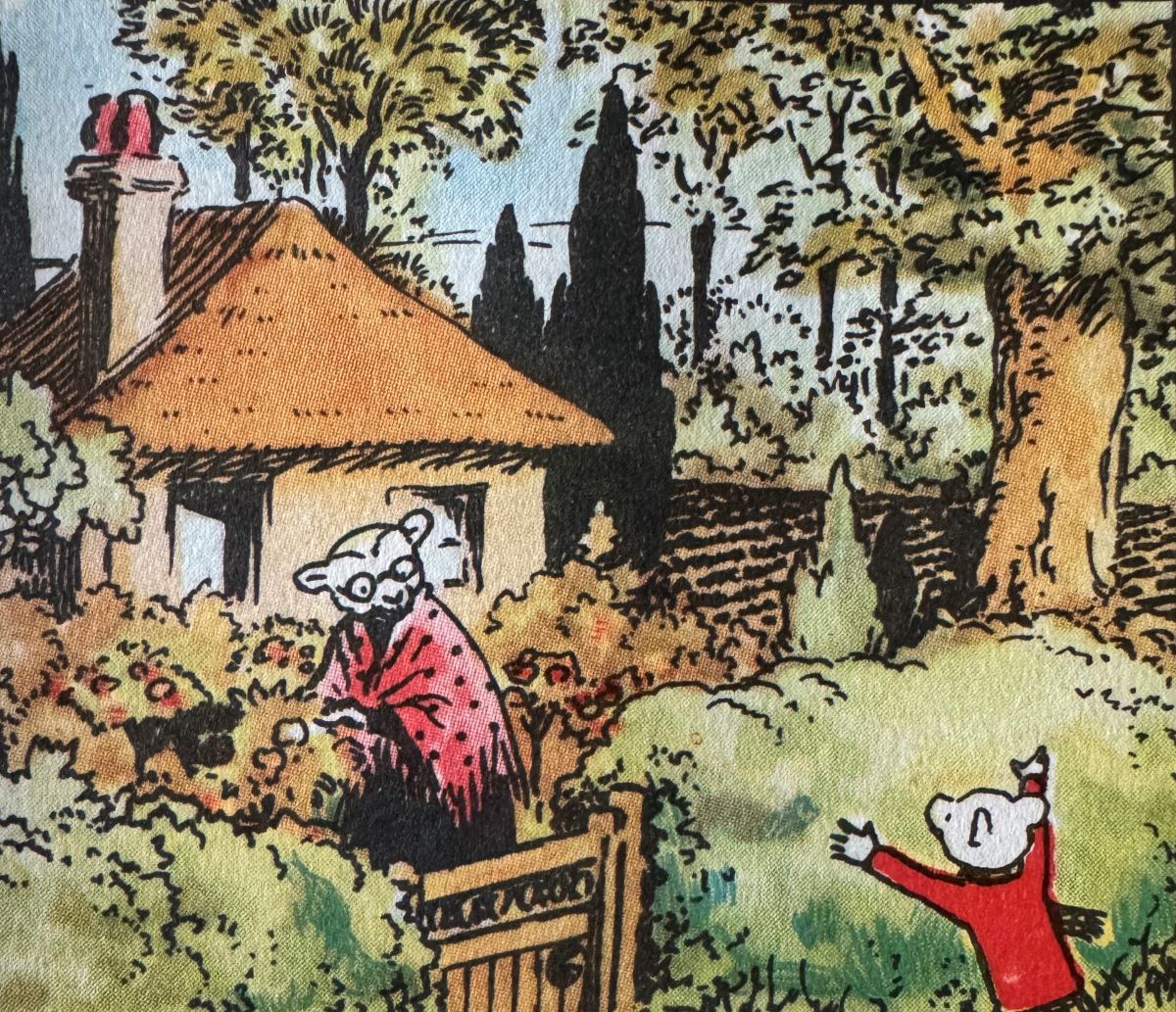
At the slightly larger end of the scale, many of the same stylistic features are still found. The house of Beppo’s unnamed owner (Beppo being a monkey) has the trellised porch swathed in roses, and shrubs under the windows of the house, as well as a substantial front hedge, and a particularly ornate blue gate. It also has a very large and established orchard. Barbara’s house is surrounded by a substantial shrubbery and trees. Within is a large circular lawn, containing two small flowerbeds; adjoining the lawn is an octagonal summerhouse, with conical roof. Mrs Jones’ garden is larger still, with a significant lawn bisected by a path, and established trees. Narrow borders surround the house, with a particular concentration of plants nearest the front door. A rainwater barrel is tucked away out of sight.
Nutwood’s Polite Architecture
The environs of Nutwood contain a good number of rather larger and more formally designed homes, too. For instance, thanks to Rupert’s treasure-finding skills, Peter and his grandfather were able to move from the cottage described above back to their rightful home, a nearby castle. The estate includes woodland, glades, lawns, and shrubberies. Squire Robinson lives by the river, but, though his house is larger, he too has a path leading through lawns and thickly planted borders to his central front door. The garden belonging to the unnamed occupant of Deepwood Hall also has a path, leading from a rather more formal entrance than the wooden gates seen in the more vernacular properties, extensive lawns, shrubs, trees, hedges, and – not seen elsewhere – a tree seat.
The Professor’s Tower is apparently modelled on Ruthin Castle, in North Wales. The front door is accessed by a straight gravel path, with lawn and shrubs to either side; climbers work their way up the walls of the house. A winding gravel path runs through lawns and a wilderness (complete with bench) to a terrace. The 1950 annual presents a puzzle based on the Professor’s ‘new garden’: a large maze in the form of a parterre between the formal terrace and woodland, ornamented with a sundial, small and large ponds, and a summerhouse.
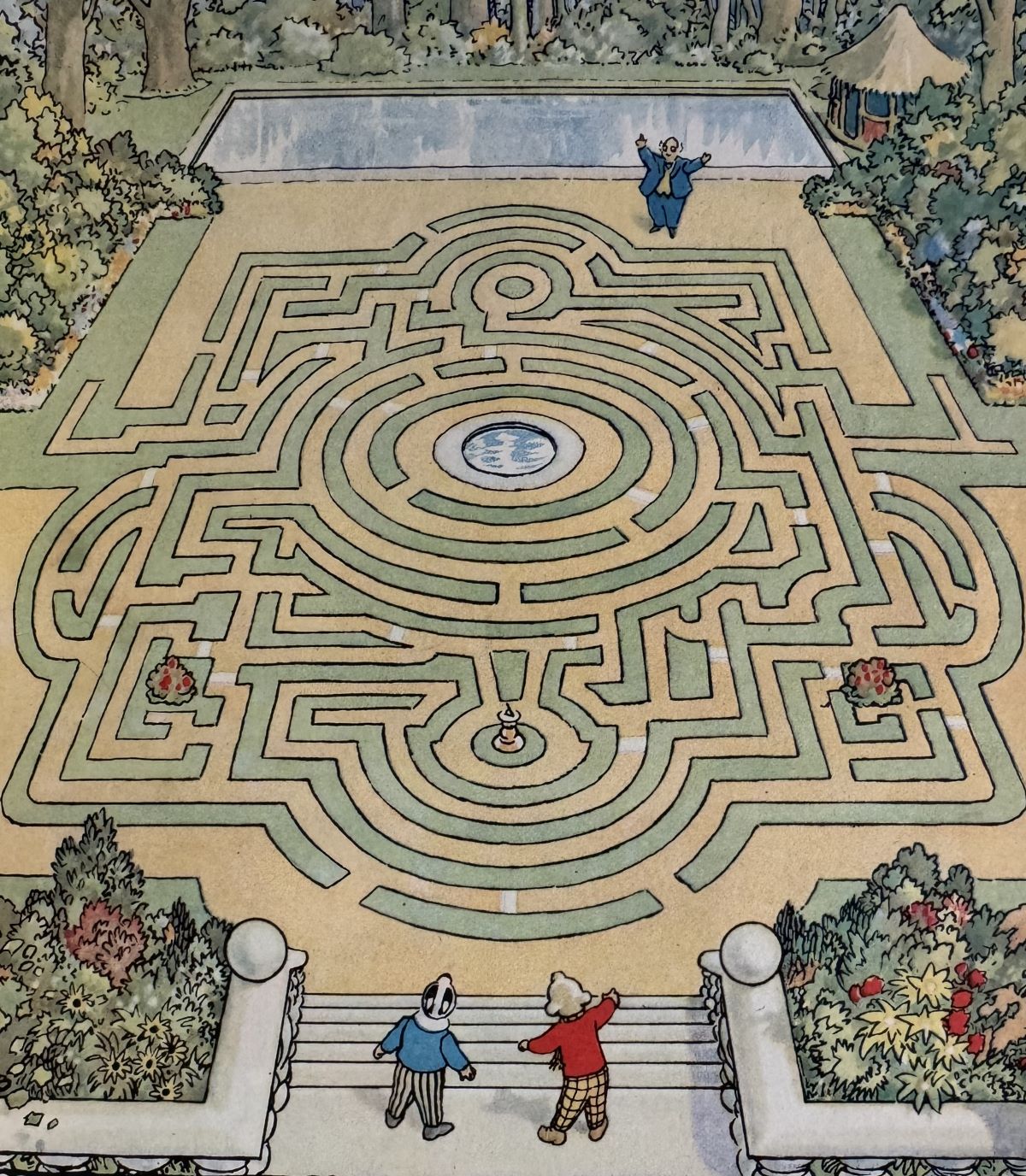
Some of the polite architecture in and around Nutwood is Chinese in origin. The gravel path to Pong Ping’s house runs through an arch cut into a neatly trimmed tall hedge. Once through the hedge, it is edged with a blue strip, either side of which is an extensive lawn sprinkled with the occasional flowerbed, and lined by mature trees and shrubs. Or, on occasion, the path has a line of what could well be box plants to each side of it. What looks like an acer is placed in the flowerbed beneath the (round) windows, and flowering shrubs in wooden tubs flank the front door. Pong Ping also has a shed, which is as ornate as the house.
The Conjuror’s house (home of the Conjuror and Tiger Lily) has the same form of boundary hedge as Pong Ping, complete with arch, defining a broadly square garden. The path that leads through it is crazy paving rather than gravel, however, and runs to the front door, itself flanked by lion statues. To either side of the path (which is sometimes cobbled) is lawn, and, beyond that, established trees and shrubs, though there are exotic fruit trees within the lawn, and small flowerbeds at the angles of the house. The whole estate is viewed from the air in one scene, and is surprisingly consistent with (most of) the detailed views from ground level.
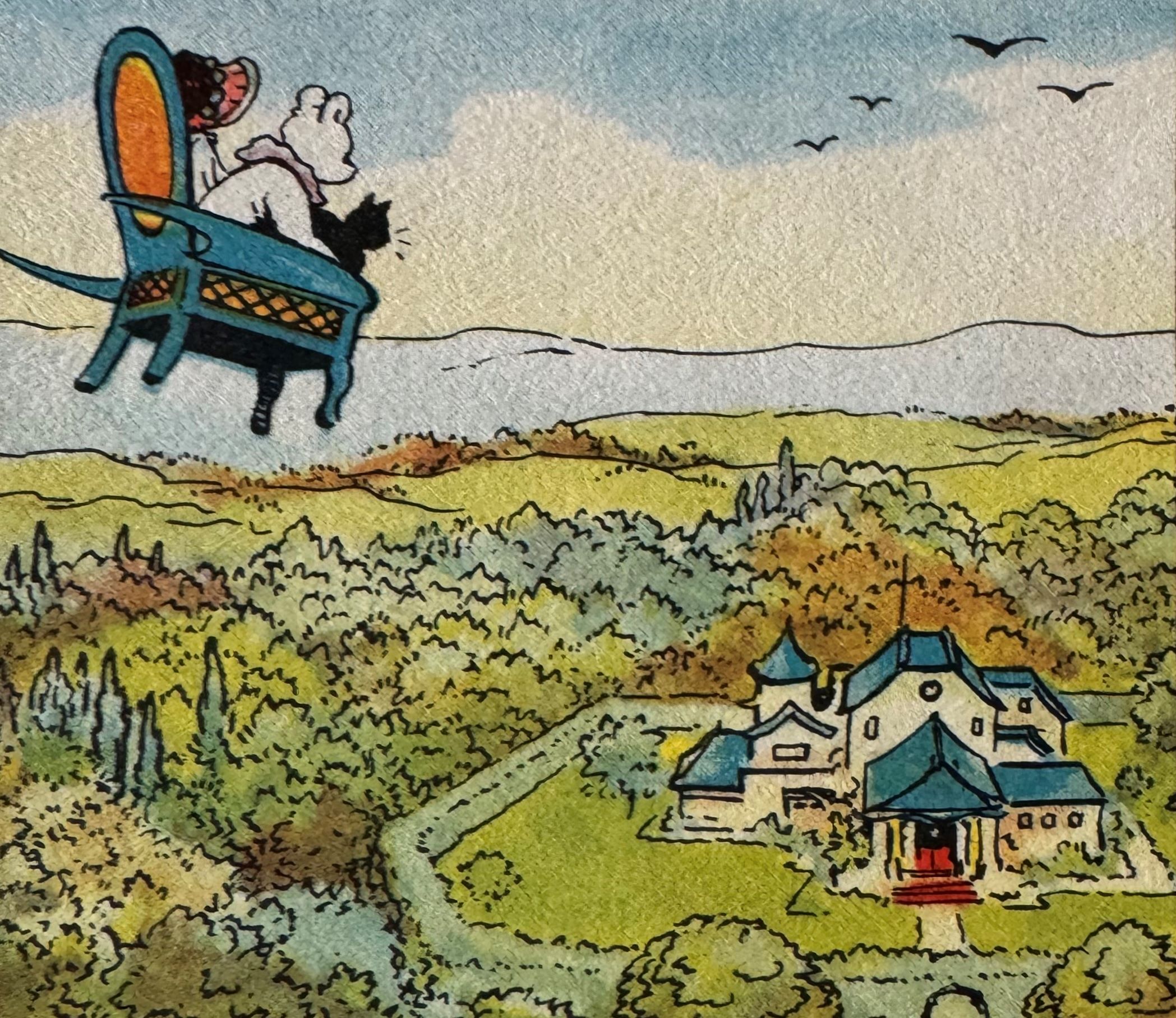
Nutchester Park
When the pupils of Nutwood’s school go on a trip to the ‘big town’, we are introduced to Nutchester Park. With wide winding paths, extensive (and neatly edged) lawned areas, and established trees and shrubs, it looks to be a very traditional park of the 1940s. It is ornamented with benches, a possible bandstand, and what looks very much like a ‘keep off the grass’ sign.
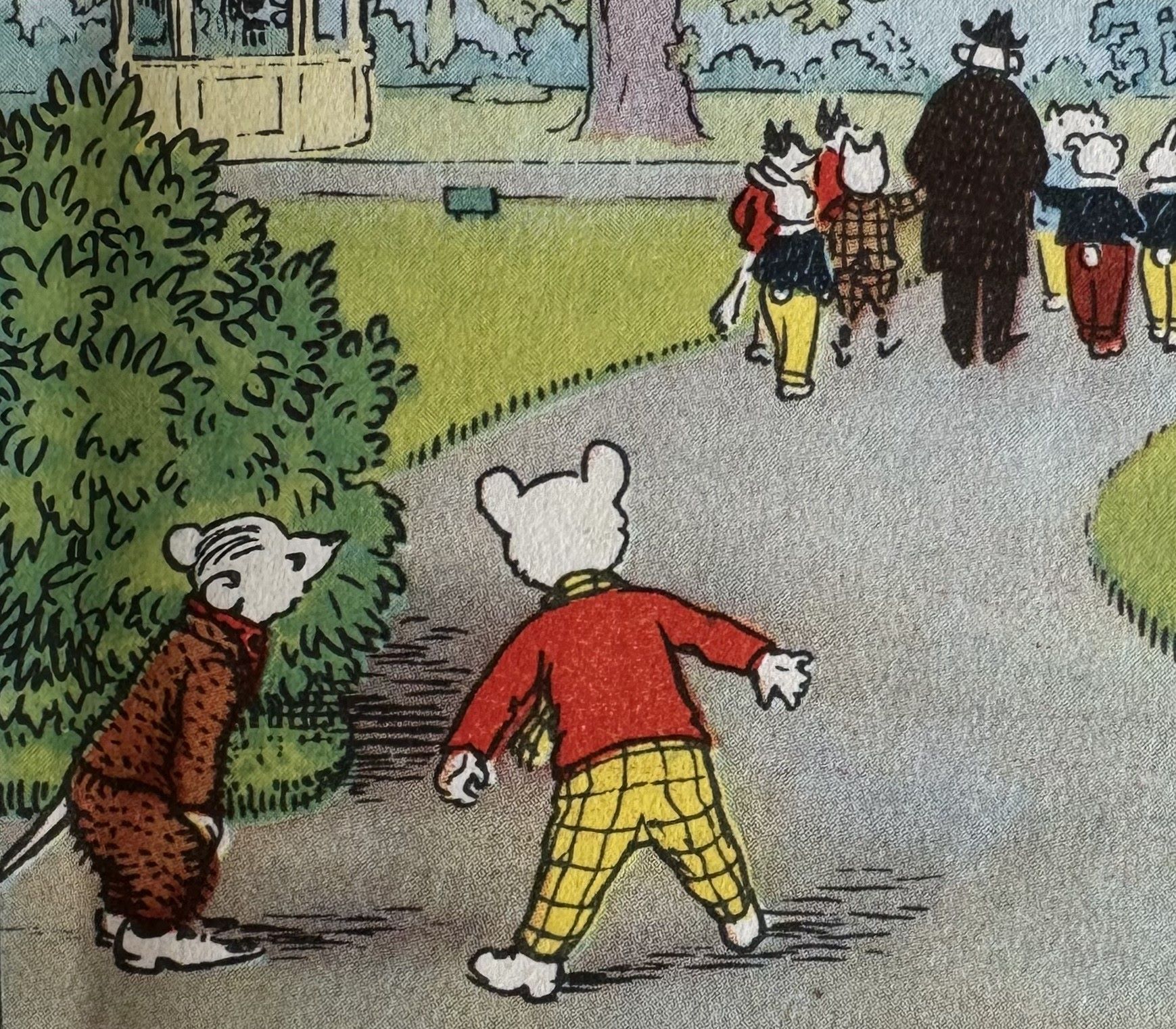
Conclusion
The era in which the Rupert stories are set is not always entirely clear. The outfits worn by characters date variously from the sixteenth century, Georgian era, Victorian era, and several decades of the early twentieth century. The gardens, though, seem a little more stable, being quite firmly grounded in the 1930s and 1940s. The plants in these gardens are generally indicated rather than explicitly presented, but sunflowers, apple trees, acers and roses all appear in recognisable forms. The tasks undertaken in these gardens are also recognisable: weeding, a bonfire to burn fallen branches, and pest control. These were practical gardens, too, with an emphasis on the production of fruit and vegetables, the provision of space in which to beat carpets and dry laundry, and the harvesting of water. With common features, but their own individual styles, all were charming, but, perhaps most importantly, all provided an environment in which Rupert and friends could play.
